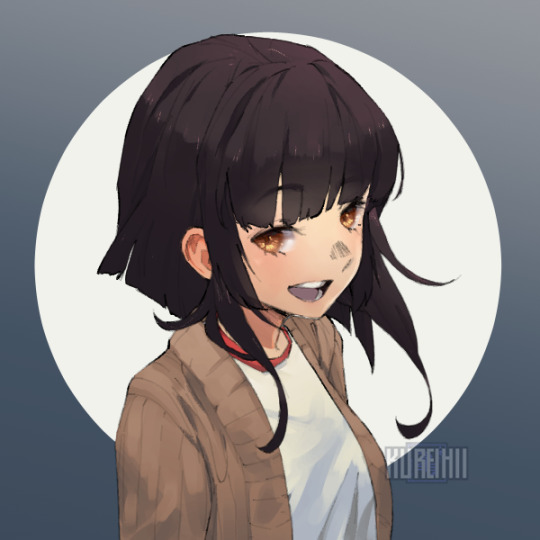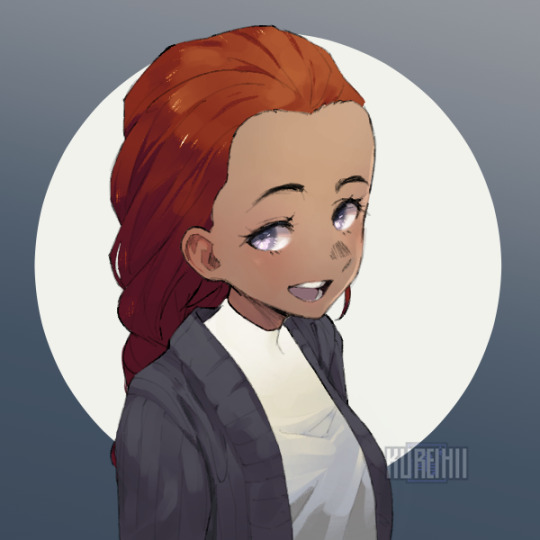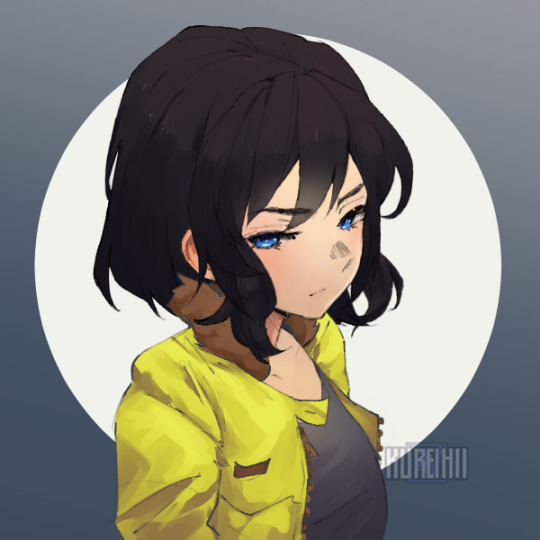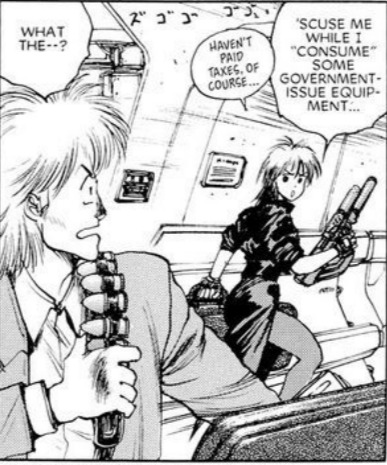#ghost in the shell human error processor
Explore tagged Tumblr posts
Text

Batou & Saito by Shirow Masamune
#batou#saito#cyborgs#male#male cyborgs#manga characters#manga character#ghost in the shell human error processor#ghost in the shell#human error processor#ghost in the shell 1.5#manga#shirow masamune#masamune shirow#author#artist#japanese#manga author#manga artist#japanese author#japanese artist#kodansha#kodansha comics#deluxe edition#manga series#cyberpunk#cyberpunk manga#cyberpunk manga series#japanese manga#japanese manga series
13 notes
·
View notes
Text



APPARITION FROM YOUR DEEPEST CYBERNETIC FEVER-DREAMS -- MADE IN JAPAN, BABY!
PIC(S) INFO: Resolution at 1118x1783 -- Mega spotlight on cover art to "Ghost in the Shell 1.5: Human-Error Processor" Vol. 1 #3, published by Dark Horse Comics on December 20, 2006. Artwork by Shirow Masamune.
MINI-OVERVIEW: "Cybercrime special-ops unit Section 9 has been mobilized to protect a key witness in a trial involving defective micro machines. And the witness definitely needs protection-from remote-controlled corpses packing serious hardware! And if the identity of these dead assassins' pilots isn't enough of a mystery for Section 9, how about the unexpected appearance of long-missing special agent Motoko Kusanagi!
"Ghost in the Shell 1.5: Human-Error Processor" presents for the first time in America the "lost" Ghost in the Shell stories, created by Shirow Masamune after completing work on the original "Ghost in the Shell" manga and prior to his tour-de-force, "Ghost in the Shell 2: Man-Machine Interface." This deluxe-format issue concludes "Fat Cat," the first of four "Ghost in the Shell" tales."
-- DARK HORSE COMICS
Sources: www.kidfenris.com/2010/03/rise-and-fall-of-masamune-shirow.html, X, various, etc...
#Shirow Masamune#Masamune Shirow Artist#Masamune Shirow#Ghost in the Shell#Ghost in the Shell 1.5#Anime and Manga#Anime & Manga#Dark Horse Comics#Dark Horse Books#Shirow Masamune Artist#Cyberpunk Manga#Female body#Female form#Female figure#Perfect Female Body#Manga#Ghost in the Shell 1.5: Human-Error Processor#Japanese Style#Manga girls#Feminine beauty#Human-Error Processor#Made in Japan#Cyberpunk
5 notes
·
View notes
Text

Ghost In The Shell: Human Error Processor
Art by Masamune Shirow
#art#lineart#illustration#pencil#ink#comics#line#cyberpunk#anime and manga#GITS#ghost in the shell#masamune shirow
110 notes
·
View notes
Text

The Ghost in the Shell 1.5: Human-Error Processor
135 notes
·
View notes
Video
youtube
The Ghost In The Shell 1.5: Human-Error Processor
#youtube#masamune shirow#japanese artist#japanese art#japanese comics#manga#science fiction#cyberpunk#ghost in the shell
2 notes
·
View notes
Text
GHOST IN THE SHELL- Kôkaku kidôtai: S.A.C. 2nd GIG - Individual Eleven | Animación | CINE EN CASA
Ghost in the Shell (攻殻機動隊 Kōkaku Kidōtai?) es un manga de ciencia ficción creado por Masamune Shirow, que progresó en dos mangas más titulados Ghost in the Shell 2: Man/Machine Interface y Ghost in the Shell 1.5: Human-Error Processor, dos películas animadas dirigidas por Mamoru Oshii: Ghost in the Shell y Ghost in the Shell 2: Innocence,1 una serie de televisión con dos temporadas…
0 notes
Photo

Ghost In The Shell: Human Error Processor Art by Masamune Shirow
190 notes
·
View notes
Text
Hello, people of Tumblr! How has everyone been? As always, I hope very well.
This time I bring you a post, the result of a small self-imposed challenge: recreating various versions of Motoko Kusanagi, the cyborg protagonist of Ghost In The Shell, on the Picrew site, in particular, a little game called "Femenine Character Creator" made by artist @kureihii.
Quite simply, despite some limitations, I was more than satisfied and happy with the result, recreating nine versions of Motoko Kusanagi; Each image comes with the name of the character and to which respective stage of the franchise it belongs. I certainly had a fun time and I think I have achieved the desired result, but I will let you judge the work.
Femenine Character Creator (Try it!)
Credits: @kureihii

Motoko Kusanagi (The Ghost In The Shell, 1989)

Motoko Aramaki (The Ghost In The Shell 2: Man Machine Interface, 1991)

Chroma Aramaki (The Ghost In The Shell 1.5: Human Error Processor, 1991)

Motoko Kusanagi (Ghost In The Shell, 1995)

Motoko Kusanagi (Ghost In The Shell 2: Innocence, 2004)

Motoko Kusanagi (Ghost In The Shell: Stand Alone Complex / Ghost In The Shell: SAC 2nd GIG, 2002 - 2005)

Motoko Kusanagi (Ghost In The Shell: ARISE - Alternative Architecture, 2015)

Mira Killian / Motoko Kusanagi (Ghost In The Shell, 2017)

Motoko Kusanagi (Ghost In The Shell SAC_2045, 2020)
Greetings!
Rankakiu
#ghost in the shell#ghost in the shell 1995#ghost in the shell manga#ghost in the shell stand alone complex#ghost in the shell arise#ghost in the shell 2017#ghost in the shell sac 2045#motoko kusanagi#kusanagi motoko#major motoko kusanagi#major kusanagi#picrew#rankakiu
55 notes
·
View notes
Text
ghost in the shell
Character/Pairing: Aikoto—Aigis, Makoto
A/N: Wrote this for the @aikotozine. I’m not 100% happy with it but I’ll leave it alone. :/
Summary: Customer #3. Never found without his coffee and his headphones. Always walking straight out of the shop. It was a deviation of the norm that he was standing here, in front of her. Aigis would have to investigate this.
...
...
...
...
“Have you pinpointed the bug yet?”
“Do you know how much code’s in her? It’ll take months.”
“We don’t have months! She was supposed to be fully operational by now.”
“Well, I can’t make it any faster! Why don’t we just reboot the system?”
-x-
“French vanilla,” repeat customer #3 requested, his voice almost inaudible.
From her corner, Aigis could only tell what he asked by reading his lips. Her seat offered her a view of the entire coffee shop, allowing her to study the customers discretely. For the most part, there were no issues but repeat customer #3 always talked quietly, too quietly sometimes for even her sensors to pick it up. From her observations, humans with headphones generally talked at a higher or lower pitch than the norm, but even this was beyond that.
For that matter, she had never seen him without those headphones. What was he listening to? Other repeated customers would generally take off their headphones while they ordered but he never removed his. Even his hair seemed to get in the way, his long blue-black bangs covering an eye. What sort of human voluntarily deafened and blinded themselves? As though he noticed her stare, he turned to her and gave her a smile.
That was a deviation from the norm. Aigis put a bookmark on his file.
-x-
“Reboot? That’s expensive.”
“It’d be more expensive to lose her.”
“We could still lose her—I’m not sure how much data this will wipe.”
“Do it anyways. We’re behind schedule as it is—the battle’ll be over before we deploy her.”
-x-
Social interactions, Aigis had been told, were the point of this exercise. They had filled her with enough knowledge to do almost anything, but she needed to learn how to interact with humans.
So she spent her mornings in this café, recording people and their behaviours and now repeat customer #3 was sitting across from her. While she could not understand his intentions—lust? Curiosity? Boredom?—this was the next step for social learning.
If she succeeded at this, then she would be considered complete. Her processors ran through various greetings and she settled on an appropriate one. “Hello. The weather is great.”
Repeat customer #3 raised an eyebrow and glanced out the window. It was raining. She had picked the wrong starter. Before she could correct herself, he asked, “Do you like the rain?”
His voice was firmer than she’d expected, considering how soft it was. He slid his headphones off till they rested on his collarbone. Aigis slowly shook her head, remembering the action from the lead scientist. “No.”
If anything, that confused him even more. He opened his mouth to ask a question and then seemed to think better of it. Slowly, he stirred his coffee as Aigis waited for him to speak. That was how conversations went—each person spoke in turn.
Unless she had accidentally terminated it. Which was possible, the other scientists often stopped talking after ‘no’ as well. Before she could verify, the repeat customer held out his hand. “I’m Makoto.”
Makoto. She updated his file, committing his name to memory. “Aigis,” she answered, taking his hand and squeezing it. As he winced, she quickly reduced the pressure of her grip. His skin was more calloused than she’d expected. There were bags under his eyes, a sign of that he needed more sleep.
“You have a strong grip.” He shook his hand when she released it.
“I am very strong,” she confirmed. When he didn’t say anything, she considered mentioning her specs. Perhaps he needed to know what alloy—Makoto laughed. Uncertain of how to respond, she stared at him. Had she missed a joke? “Is something funny?”
“No.” He shook his head and took a sip of his coffee. “You’re here every day, right?”
“Yes. Every morning.”
“That’s good.” He smiled at her. “I’ll see you tomorrow too, then.”
-x-
“Reboot initiated: 10, 9, 8...”
-x-
“You don’t like coffee?” Makoto asked as he sipped his usual. “Why are you in a cafe?”
“Studies,” she responded honestly. For some reason, the café felt emptier than usual—were the walls always so plain?—but Aigis paid it no mind.
True to his word, Makoto chatted with her daily now. Apparently he was a student though Aigis was not certain if a student should be drinking so much caffeine. There were plenty of studies that mentioned the harm to his health and even the cost benefits of withholding purchases. When she’d brought it up, he had laughed again. Somehow, she was very good at making him laugh. Just like the rest of him, it was quiet laugh. It fascinated her all the same.
Makoto rested his cheek on his hand. “Are you an exchange student?”
Aigis considered his question, examining her clothes. The black school uniform was supposed to help her blend in with the locals. “Why do you think I’m a foreigner?”
“Your hair.” He inclined his head, indicating her blond locks.
She touched them gingerly. Perhaps she should get them painted over. It was true that her hair colour was not the most common one in this region. “I see.”
His eyes never left hers and she wondered just who was the observer between them. “What do you study?”
There were a dozen ways to answer this. She picked the simplest one. “People.”
A flash of confusion crossed his face before he shrugged. He did that a lot too and she updated her conversation algorithms. Clearly that was not a typical response. “Apathy syndrome? It’s been more frequent lately, hasn’t it?”
Not quite what Aigis meant but she nodded her head. “The number of customers here has dropped recently.”
Something flickered across his face, a dark expression she couldn’t quite understand. “It’ll be fixed soon.”
“How do you know?” She had yet to find any medical records indicating a cure.
“Just…a hunch.” A lie. Aigis could see it in his body language. Before she could press, he changed the topic, holding out his headphones. “There’s a band I’m listening to recently. Want to listen?”
It was an obvious attempt to change the topic. She should follow up on him but her hand reached out for the headphones instead. It was strange; Aigis found herself doing a lot of illogical things with him. The sound of guitar played as she slid the pair on, a woman talking more than singing along: Dreamless dorm, Ticking clock. “This is nonsense.”
“Maybe. It’s called Burn My Dread,” Makoto replied, not offended in the least. There was a slight curl of his lips, a softening of his eyes, indications she had learned to recognize as joy for him.
She listened to the whole song, recording it and adding it to his file.
-x-
“…80%, 82%, 86%...”
-x-
“Hey, Aigis?” Makoto hesitantly sat next to her.
He was not normally that shy and she stared at his face. For some reason, it was hard to focus on his features, to find any distinctions. Even his voice sounded off, like an old recording. “Makoto?”
He gripped his headphones, a nervous tic of his. It was serious then. Important. “There’s something I have to do, to help everyone. To help you.” He swallowed and then looked at her eyes. “I’m not sure if I’ll survive it.”
“Makoto?”
“I’ll try to come back to you, Aigis. I lo—”
Aigis couldn’t hear his voice anymore. There were no lips to read, no expressions to guess off. What little of the café was left had disappeared, leaving only the two of them sitting in a white void. His hands reached out to grip hers but the sensation was lost.
Before she could reach back, he disappeared.
-x-
“All right, reboot complete!”
“Good, double check her systems.”
Aigis could hear voices. Soft, indistinct voices, as though they were coming through a filter. Her eyes refused to open and her sensors were off. Briefly, she wondered if she were injured.
“Looks good. I see no traces of Makoto in her databanks anymore.”
“I still don’t get it, how did she create a set of false memories? She can’t imagine anything.”
“A malfunction, probably. Or a virus.”
“I wonder why the barista only called us now—she must have been talking to herself for months. Oh, sir, you came back in time.”
A new voice joined the mix. “How is she?”
Suddenly, Aigis could move again and she opened her eyes. She was in the lab again. “Did I get injured?” she asked. She was not scheduled for a check up.
“You’re awake.” A man with an eyepatch looked down at her. Kirijo, her data helpfully informed her. “Run diagnostics.”
Aigis double checked her operations. “No errors to report.”
“Aigis, do you know anything of a Makoto?”
“Makoto?” She cross-referenced her data. “A popular name for both male and female Japanese infants. Should I go into more detail?”
“No, that’s fine.” Kirijo studied her once more. “Perhaps if you were ready to fight in time, we might not have lost him. Maybe it wouldn’t have come to down to this.”
Confused, Aigis stared. “Ready to fight what?”
“Nyx, though I suppose that’s no longer important.” He turned to go. “I am sorry for what happened. To Makoto. It’s one thing to die, it’s another to be erased.”
“Makoto,” she repeated and she wondered how a single word could feel so sad.
-x-
Aigis sat in a café, in a booth with the best view of the room. She could see everyone from here and for the most part, hear them as well. It was a good way to learn about social etiquette, the last thing she had to acquire to be complete.
The barista set down a French vanilla in front of her. “Are you sure you want this?”
She stared down at the drink. It was meaningless to her, she could not taste it. Despite that, somehow it felt right and she nodded to her. “This is fine.”
Maybe she could use that to converse with the other patrons. They all had drinks, after all. Aigis sat back and watched as the door opened and a woman stepped in. Faintly, in the back of her head, she heard an electric guitar play.
I’ll lift my face and run to the sunlight.
The words comforted her, for some reason. Maybe today she’d try initiating a conversation.
30 notes
·
View notes
Text




The Covers of the Fully Compiled Deluxe Edition and the Single Deluxe Editions
#ghost in the shell#ghost in the shell mangas#ghost in the shell manga#ghost in the shell human error processor#ghost in the shell 1.5#human error processor#ghost in the shell 2#man machine interface#ghost in the shell man machine interface#manga#mangas#shirow masamune#masamune shirow#author#artist#japanese#japanese author#japanese artist#manga author#manga artist#kodansha#kodansha comics#deluxe edition#deluxe editions#hardcover#hardcovers#cyberpunk#cyberpunk mangas#futuristic#futuristic mangas
12 notes
·
View notes
Text
Ghost in the Shell, nuovo manga in arrivo per la popolare saga cyberpunk
Il primo capitolo sarà pubblicato in Giappone il 20 settembre.

Il regista e sceneggiatore Jun'ichi Fujisaku ha annunciato che tornerà ad immergersi nel futuro di Ghost in the Shell assieme all’illustratore Hiroki Yoshimoto con un nuovo manga intitolato “Ghost in the Shell: The Human Algorithm”. Il primo capitolo della nuova serie a fumetti dell’iconica opera cyberpunk ideata da Masamune Shirow uscirà sulla rivista Young Magazine di Kodansha il 20 settembre. Il manga uscirà ogni due settimane anche sull’app Comic Days.
La storia sarà ambientata dopo “Ghost in the Shell 1.5: Human-Error Processor” e prima di “Ghost in the Shell 2: Manmachine Interface”, seguerndo la Sezione 9 dopo la scomparsa del Maggiore e focalizzandosi su Togusa, Bato, Azuma, Ishikawa e la nuova recluta Tsunagi.
In precedenza, Fujisaku ha lavorato alla sceneggiatura per le serie animate di “Ghost in the Shell: Stand Alone Complex” e “Ghost in the Shell: Stand Alone Complex 2nd GIG”, oltre che supervisionare la produzione di “Ghost in the Shell: Arise”.
SilenziO)))
[FONTE]
#manga#ghost in the shell#ghost in the shell the human algorithm#junichi fujisaku#hiroki yoshimoto#young magazine#kodansha#newsintheshell#news in the shell#sci-fi#cyberpunk#poliziesco#seinen
2 notes
·
View notes
Photo

Ghost in the Shell 1.5: Human-Error Processor
#made in japan#cyberpunk#ghost in the shell#manga#masamune shirow#gits#monochrome#black and white#cyborg#actuators
530 notes
·
View notes
Photo


My Manga Of The Month:
Count Cain
Ghost In The Shell 1.5 Human Error Processor
5 notes
·
View notes
Text
Ghost In The Shell – The Human Algorithm Manga Review
Ghost In The Shell – The Human Algorithm 攻殻機動隊 is a manga based on the highly acclaimed Ghost In The Shell franchise created by Masamune Shirow, with the story written by Junichi Fujisaku and art work by Yuki Yoshimoto.
Following her disappearance, an abandoned prosthetic body resembling Section 9’s Motoko Kusanagi has been found In the Northeastern area of Towada. Togusa heads up the investigation with a new recruit, with leads that the case could be connected to the religious cult named Aterui. Meanwhile, a different report indicates that the Major has also been spotted in Okinawa, as Batou and Ishikawa runs into trouble with the Chinese Mafia’s turf in the area. Will they discover the truth behind the Major’s disappearance ?
It’s been quite a while since I’ve read any Ghost In The Shell manga since Masamune’s original work, but I was drawn to the excellent cover art by Yuki Yoshimoto, and the actual art work of the manga is pretty decent as well.
youtube
I’ve yet to finish reading the manga, but the art work by Yuki Yoshimoto is pretty good and certainly enough to keep me interested to find out what comes next in future volumes. If you’re a Ghost In The Shell fan looking for some new manga content from the franchise, this is definitely worth checking out.
“Ghost In The Shell – The Human Algorithm Manga 攻殻機動隊 コミック 吉本祐樹” manga details :
Dimensions – 21 x 15 x 2 cm Softcover, 256 pages In Japanese language

Buy From Amazon.com | Amazon CA | Amazon UK | Amazon FR | Amazon IT | Amazon DE | Amazon ES
You might also be interested in these items :


The post Ghost In The Shell – The Human Algorithm Manga Review appeared first on Halcyon Realms - Art Book Reviews - Anime, Manga, Film, Photography.
4
Related Posts:

Ghost In The Shell 1.5 – Human Error Processor Manga Review

Ghost In The Shell 2 – Man Machine Interface Manga Review

Ghost In The Shell SAC_2045 Official Visual Book Review

Ghost In The Shell Genga Collection Art Book Review

Ghost In The Shell 25th Anniversary Art Exhibition
By: yonghow
0 notes
Photo

Ghost In The Shell 1.5: Human-Error Processor Art by Masamune Shirow
700 notes
·
View notes
Text

@yourfavecommitstaxfraud
The Major/Chroma from Ghost in the Shell 1.5 Human Error Processor commits tax fraud!
0 notes